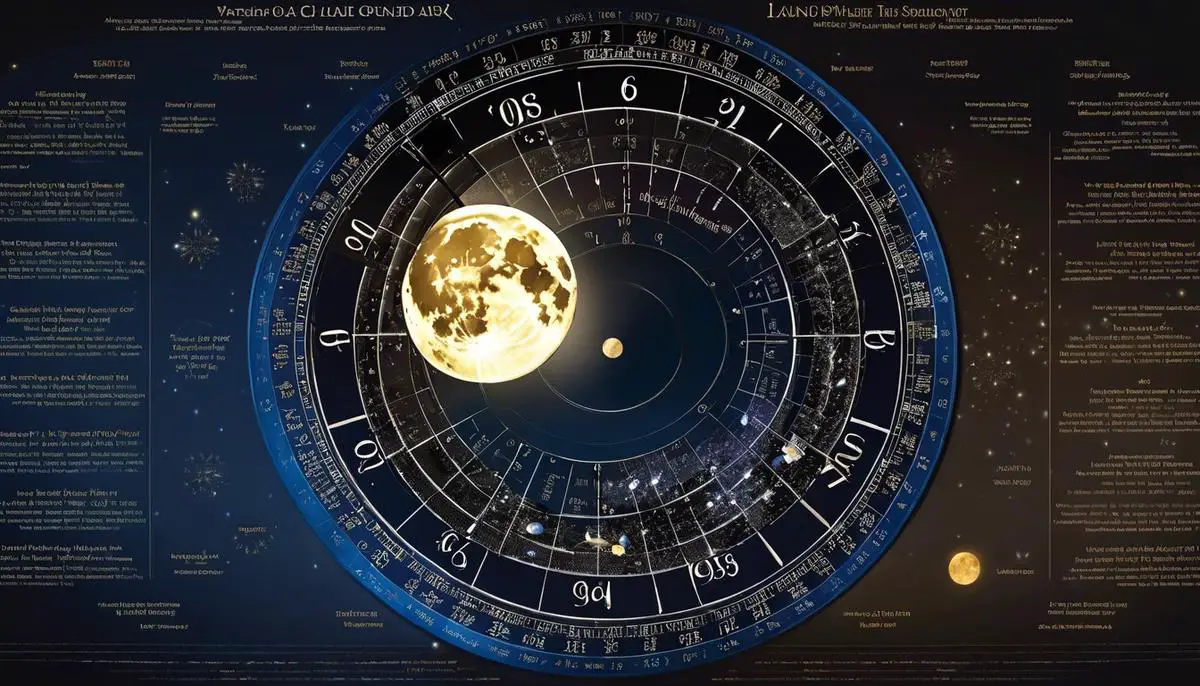The moon’s celestial journey perpetually enchants gardeners, who look to its luminous guidance to harness the ancient art of moon phase gardening. As we delve into the realm of lunar influence this February, the full moon presents a unique opportunity to align our gardening practices with the cosmic ebb and flow. Understanding the nuances of this method is not only fascinating but also practically beneficial, as it taps into the full moon’s sway over earthbound cycles. During this frosty month, we will explore how the full moon phase can nurture the very roots of our garden. By learning its secrets, we unveil the potential for encouraging robust root growth and optimal planting conditions, particularly for those hearty vegetables and plants that defy the chill of winter’s tail end.
Understanding Moon Phase Gardening
Unlocking the Moon’s Mysteries: How the Lunar Cycle Influences Plant Growth in February
Grasping the Lunar Effect on Green Growth
Ever wondered how the moon, the celestial body that brightens the night sky, might be influencing your garden? The subtle, yet profound impact of the lunar cycle on plant growth catches the attention of many gardening enthusiasts, especially during the unique month of February. Understanding this natural phenomenon can be eye-opening and useful for anyone nurturing plants, whether they’re budding gardeners or have a green thumb.
The Lunar Cycle Breakdown: A Crucial Frame for Planting
It all starts with the basics: the lunar cycle spans approximately 29.5 days, transitioning from new moon to full moon and back again. This cycle is a blueprint for gardeners to align their planting schedules with nature’s pulse. As February rolls in, the days start to stretch, and the moon’s phases can guide you to maximize plant growth.
New Moon to First Quarter: Planting Seeds for Success
The first phase, from the new moon to the first quarter, is marked by increasing moonlight and gravitational pull. It’s an ideal time to sow seeds that benefit from strong root development. Think about root crops and leafy greens that thrive on sturdy foundations. The waxing crescent that follows the new moon is like a green light for seedlings to break through the soil and reach for the sky.
First Quarter to Full Moon: Encouraging Upward Growth
As the moon waxes toward its full, brilliant self, plants are encouraged to grow leaves and stems. The light reflected off the moon grows brighter, and just like sunbathers on a beach, plants seem to bask in this extra lunar glow, channeling it into above-ground growth. Leafy vegetables and grains commonly sown during the waxing gibbous phase can capitalize on this phase energetically.
Full Moon to Last Quarter: Absorbing the Moon’s Bounty
The pinnacle of the lunar cycle, the full moon, showcases an intense interplay of light and dark. The gravitational pull is at its peak, and the moonlit nights are at their brightest, which could signal a temporary surge in sap flow. It’s a moment for pause in the planting spree, a chance to let plants absorb the moon’s offerings.
Last Quarter to New Moon: Prepping and Maintaining
Post full moon, as light diminishes and the moon wanes, it’s a signal to transition from active planting to maintenance. It’s time to prune, harvest, or transplant. This lower light period focuses energy back down into the roots, supporting the plant’s survival system and providing a stable base for future growth spurts.
Harnessing the Lunar Rhythm
In February, the cold may linger, with spring just flirting with the horizon. Aligning gardening practices with the lunar phases can provide a unique edge, helping to coax the most out of the plants as they prepare for the onset of spring’s warmth. By tapping into the natural ebb and flow of the lunar cycle, gardeners can encourage robust growth in their plants, from root to tip.
Whether it’s planting by the waxing light, pruning in the waning glow, or resting under a full moon, the lunar cycle presents a harmonious dance with nature. It’s not just about following a calendar but interacting with a living lunar tapestry. While the moon quietly orbits, it imparts a rhythm like an unseen conductor to the natural world below.
Engage in this sublime lunar symphony and watch as February’s frost gives way to the subtle lunar pull, beckoning plants to stretch towards the burgeoning spring. No summary required here; simply step outside, look up, and let the moon guide your green journey.

February Full Moon Planting Guide
Sowing by the Silver Light: Selecting the Best Plants for February’s Full Moon
Embracing the silvery glow of February’s full moon can be transformative for a gardening enthusiast. Poised in the chill of late winter, many may not consider this a time for planting. However, as an aficionado of lunar gardening, it’s thrilling to realize how pivotal this period is for initiating growth in certain plants. The full moon’s magnetic influence is said to enrich the soil’s moisture, creating an ideal environment for seed germination. Let’s navigate through the best plant choices to sow during this lunar phase, ensuring a lush, thriving garden as the seasons turn.
Choosing Your Seeds with the Moon in Mind
When the full moon casts its light across the night sky, root crops and perennials are primed for planting. This is because the gravitational pull is at a high, encouraging root development. Consider these sturdy contenders for a robust start under the full moon’s watchful eye:
- Root Vegetables: Beetroot, Carrots, and Turnips
- Perennials: Asparagus and Rhubarb
- Leafy Greens: Spinach and Kale
The denser structure of root vegetables responds well to the robust soil conditions the full moon fosters. Sowing beetroot, carrots, and turnips during this period lays the groundwork for vigorous root systems, leading to hearty harvests in the future.
Perennials like asparagus and rhubarb are slow to establish but last for years, and initiating their journey in alignment with the full moon aids in the development of strong root foundations. This is a patient gardener’s investment, with the promise of sustainable, recurring crops.
Although not root-based, some leafy greens, like spinach and kale, are hardy enough to withstand cooler temperatures and benefit from a full moon sowing. The surge in soil moisture during this phase promotes quick and robust leaf development, leading to an early green bounty.
Guiding Your Garden to Glory
With a selection of seeds suited for the luminous full moon, here are some tips to ensure you maximize this moonlit planting window:
- Prepare the Beds: Clear any debris and break up the soil to a fine tilth to welcome new seeds. Well-aerated soil allows moisture to penetrate deeply, encouraging robust root growth.
- Sow Accordingly: Follow the natural guidance of the moon and plant your chosen seeds at the recommended depth. Root vegetables will need more depth compared to the shallower sowing of leafy greens.
- Water Wisely: Trust in the moon’s draw of moisture and avoid overwatering. The soil should be moist but not saturated to prevent seed rot and to encourage the natural growth process.
- Insulate if Needed: Given February’s unpredictable weather, it may be necessary to provide some frost protection. A light layer of mulch or a fleece covering can shield your new sown seeds from any harsh, lingering frosts.
- Be Observant: As seeds begin to sprout, monitor their progress. The vibrant life emerging under the full moon is a sight to cherish, but also an indicator of when to thin seedlings and make necessary adjustments.
Sowing seeds under the full moon is a practice deep-rooted in tradition, and backed by a desire to work harmoniously with the rhythms of the natural world. Root vegetables and hardy greens, when started during the February full moon, can set the pace for a flourishing garden pulsing with life. Whether you’re a seasoned lunar gardener or a curious green-thumb, let the full moon of February be a guiding light for planting, and the silver start to a season of growth and abundance.

Post-Full Moon Garden Tasks
Garden Maintenance Post-February Full Moon: Promoting Plant Health and Vigor
Caring for your garden as it wanes from the brilliance of the February full moon is a pivotal moment for both the earth underfoot and the flora it nurtures. As the moon transitions from its full to the last quarter phase, gardeners are presented with a critical opportunity to both reinforce the health of their plants and prepare for the next lunar cycle. This phase of the moon cycle is the time to engage in maintenance activities that ensure plant vitality, control growth, and bolster resilience against pests and diseases.
Pruning for Prosperity and Healthy Plants
In the post-full moon phase, plants’ sap flow begins to slow, making it an excellent time for pruning without excessive sap loss. Focus on removing any dead or diseased branches and foliage to prevent the spread of plant diseases. Pruning can encourage bushier growth and give shape to your plants, ensuring they look their best.
Watering Wisely
Although the full moon and its gravitational pull can increase moisture in the soil, judicious watering after this period is still essential. Water plants deeply but infrequently to encourage strong root development, being mindful of rainfall to avoid overwatering. Remember, the goal is to maintain an even moisture level, as roots need both water and air to thrive.
Fertilizing Fundamentals
With the waning moon in effect, this is an optimal time to fertilize the soil. As the energy of plants draws downward, feeding your garden with a balanced fertilizer promotes healthy root growth and strengthens the foundation of your crops.
Soil Care
Tend to the soil by mulching, which will conserve moisture, regulate soil temperature, and deter weeds that might compete with your plants for nutrients. Organic mulches, such as straw or wood chips, will also decompose over time, adding beneficial organic matter back into the soil.
Pest and Disease Prevention
Regularly inspect your plants for signs of pests and diseases. Implementing preventative measures, such as introducing beneficial insects or applying organic pest deterrents, is essential for maintaining plant health. This is also an optimal time to stay vigilant and start treatments for any problems before they escalate.
Weeding Wherewithal
Weeds are relentless, but the post-full moon phase is a great time to uproot them. As the moon’s light diminishes, so does the vigor of weed growth, allowing for easier removal and ensuring that your plants aren’t fighting for nutrients.
Corsalettuce (Lettuce Sculpting)
This whimsical practice involves trimming lettuce heads to promote tighter growth and potentially extend their harvest period. Using clean, sharp shears, trim outer leaves about an inch above the crown. This technique rejuvenates the plant and can make your lettuce patch a neat, tidy marvel.
Plant Support Systems
Tall plants or those with heavy blooms may start to slump as they grow. To avoid breakage and to keep pathways clear, add stakes, cages, or trellises that will support their stature. Securing your plants will also prevent them from smothering their neighbors, ensuring a harmonious and productive garden space.
Through these carefully considered steps, gardeners can expertly navigate the post-full moon period, setting the stage for seamless progress into the lunar cycle’s next phase. By attending to these maintenance tasks, you will sustain and bolster a robust garden ready to flourish in the lunar cycle’s ever-circling dance.

Embarking on the lunar gardening journey aligns us with the organic rhythms of nature, offering a unique perspective on cultivation. The wisdom of February’s full moon gardening encapsulates a harmonious blend of tradition and scientific curiosity, setting the stage for a thriving garden. As the moon wanes, we carry forward with its whispered advice, attending to necessary post-full moon tasks that favor a bountiful harvest. By heeding the celestial hints embedded in the night sky, gardeners can foster an environment where both plants and passion flourish under the watchful eye of the ever-changing moon.
![]()

Hi, its good post on the topic of media print, we all know media is a fantastic source of
facts.